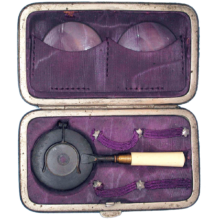Dr. Williams developed the William’s lantern around 1899. In the second half of the 1800′s, several spectacular train wrecks occurred. As a result, this led to the discovery that some of the people responsible for these trains were color blind. A lot of interest developed in testing for color vision.
In 1899, ophthalmologist, Dr. Charles H. Williams of Boston constructed a lantern. It was designed to test the color vision of railway men. In addition, in the same year he sent one to Snellen to evaluate. This was the first “William’s lantern” for color vision testing.
The instrument consists of a casing, similar to a railway lantern. It contains a candle holder. The candle flame is behind an opening at the front. Also at the front, there are a rotating disc with colored glass plates and a second rotating disc with diaphragms of different sizes.
By rotating the discs it is possible to turn all possible combinations into position in front of the illuminated opening.
US Navy study of William’s lantern for color vision.
Interestingly, in 1943 the US Navy tested this lantern for suitability of detecting color deficiencies and found it wanting.
Very hard to find if not rare.





